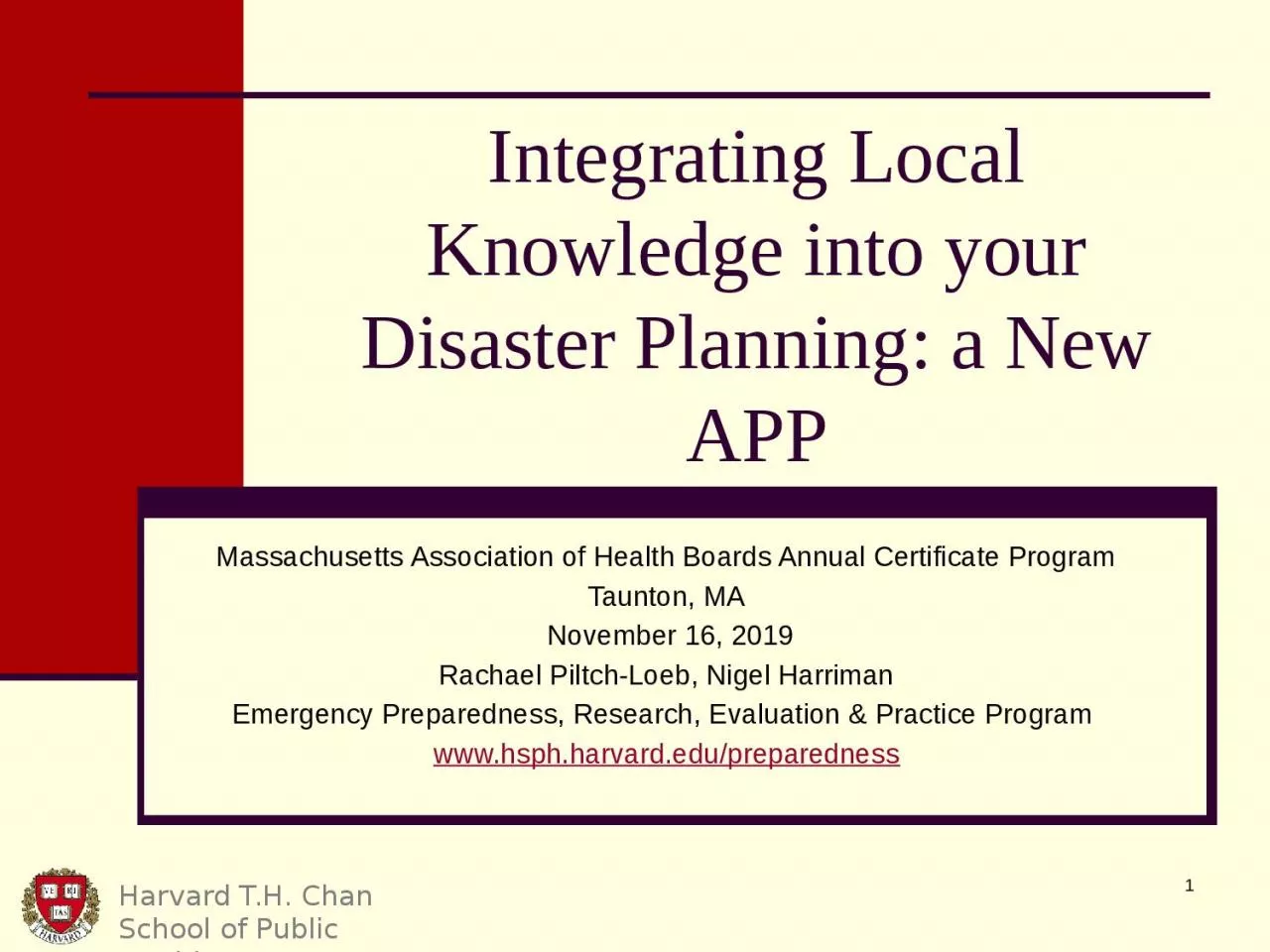

Massachusetts Association of Health Boards Annual Certificate Program Taunton MA November 16 2019 Rachael Piltch Loeb Nigel Harriman Emergency Preparedness Research Evaluation amp Practice Program ID: 1036522
Download Presentation The PPT/PDF document "1 Integrating Local Knowledge into your ..." is the property of its rightful owner. Permission is granted to download and print the materials on this web site for personal, non-commercial use only, and to display it on your personal computer provided you do not modify the materials and that you retain all copyright notices contained in the materials. By downloading content from our website, you accept the terms of this agreement.
1. 1Integrating Local Knowledge into your Disaster Planning: a New APPMassachusetts Association of Health Boards Annual Certificate ProgramTaunton, MA November 16, 2019Rachael Piltch-Loeb, Nigel HarrimanEmergency Preparedness, Research, Evaluation & Practice Program www.hsph.harvard.edu/preparedness
2. This project was supported by Broad Agency Announcement 2016-N-17770 from the U.S. Centers for Disease Control and Prevention. The contents are solely the responsibility of the authors and do not necessarily reflect the views of the CDC.Acknowledgements
3. Learning ObjectivesUnderstand the importance of supporting vulnerable populations before, during and after a disaster.Understand the potential role of local knowledge in disaster preparedness.Describe communications strategies using local knowledge to engage and support vulnerable populations in disasters.
4. Plan for Community Needs in a Disaster…Evacuation guidance…”How do I leave?”Shelter support …”Where do I go?”Basic physical needs: …”I’m hungry and thirsty!”Other needs: …”I need fuel for my generator, batteries for my flashlight, refills for my prescription.”Communications …”How can I contact my family?”And…Information! …”What is happening?”
5. Educating Your Community Before a Disaster…Disaster supplies…”Get a flashlight and batteries”Disaster Shelters…”What a shelter offers”Basic physical needs: …”Stock up on canned food”Communications …”Get a battery-operated radio”Other needs: …”Try to refill prescriptions before a storm”
6. What can make groups in your community more vulnerable? Potential determinants (root causes) of vulnerability:Economic disadvantage: e.g. homelessLanguage and literacy: limited English comprehension or non-English speakingMedical issues and disability: sensory impairment (blind, deaf) cognitive disorders, mobility limitation, suffering from addictionIsolation: geographically or culturally Age: Frail elderly
7. 7 Disaster Planning for Vulnerable Populations
8. 8Southern Hemisphere flu activity, typically occurring between April and September of each year, has been robust since early June Simulation Module 1
9. 9WHO Influenza Update of Southern Hemisphere flu data for the period of May 15- June 25:Widespread ILI activity has been noted across many South American countriesActivity is predominantly due to H1N1 Influenza A type Simulation Module 1
10. Attack rate and number of hospitalizations due to respiratory illness vary across affected countries, but appear to be notably higher than normalSpike observed in patient deaths attributable to respiratory illness: 35 deaths in Buenos Aires alone Concerns about the outbreak of severe respiratory illness associated with influenza have caught the attention of global health experts and media outlets have picked the news.10 Simulation Module 1
11. 11Virologists have detected a genetic variant in the predominant circulating strain of Southern Hemisphere H1N1 Influenza A as compared to the 2009 H1N1 strain that was These changes represent a major antigenic drift of the Influenza A H1N1 virus Simulation Module 1
12. The WHO convenes an emergency meeting with key stakeholdersBased on flu activity in the Southern Hemisphere, new recommendation issued that the previously selected composition for the Northern Hemisphere seasonal flu vaccine should be modified 12 Simulation Module 1
13. News of 2018 H1N1, or “Argentinian Flu”, as it is now popularly known, is receiving even more frequent coverage in media outlets across the globe13 Simulation Module 1
14. First case in United States!First case of Influenza is reported in Florida in a 17 year old male who returned from Argentina where he went to visit his familyThe student has been hospitalized with severe respiratory syndromeLab has confirmed the virus strain as Argentinian strainNational and international TV is covering the news.14 Simulation Module 1
15. source: NOAA You have been asked to review your emergency preparedness plans with an emphasis on: Communications with vulnerable populationsProtecting yourself: hand hygieneFlu symptoms Where to go for flu testTreatmentVaccine statusPotential for school closures and cancellation of community eventsResources for additional information Simulation Module 1
16. source: NOAA What is your plan to communicate with vulnerable populations about the pandemic flu? Discussion Module 1
17. Values, attitudes and beliefsSocial cohesion strategiesCommunications capabilityAnd...Rarely recorded…May be invisible to outsiders…WHAT IS ‘LOCAL KNOWLEDGE’? Local Knowledge Presentation Module 2
18. Examples of ‘LOCAL KNOWLEDGE’ related to emergencies.. Communications: Amateur radioLess well-known community TV and radio stationsWhere people informally meet to exchange information such as cafés or sports eventsTrusted messengersTranslatorsNon-Red Cross Disaster SheltersBasement of a church, martial arts studioOther Volunteer Groups Local Knowledge Presentation Module 2
19. Project Overview: the HELPAPP AppLocal knowledge dataPublic health disaster planners use data!Local knowledge data entry Local Knowledge Presentation Module 2
20. APP LIVE SIMULATION 20 Local Knowledge Presentation Module 2
21. source: NOAA Please review your communication plans with an emphasis on communicating with vulnerable populations...using the app data.Local Knowledge Disaster Planning with the App Module 3
22. source: NOAA How could you integrate the local knowledge app data into your plans to communicate with vulnerable populations?What would you do differently in your planning? Discussion Module 3Protecting yourself: hand hygieneFlu symptoms Where to go for flu testTreatmentVaccine statusPotential for school closures and cancellation of community eventsResources for additional information
23. Links to ResourcesHarvard School of Public Health, Preparedness and Emergency Response Learning Center http://www.hsph.harvard.edu/hperlc/CDC Emergency Preparedness and Response http://emergency.cdc.gov/Johns Hopkins Center for Public Health Preparedness, Risk Communication Strategies for Public Health Preparedness http://www.jhsph.edu/preparedness/training/online/riskcomm.html